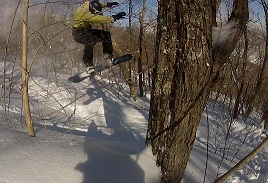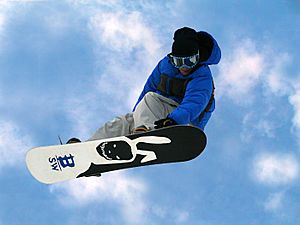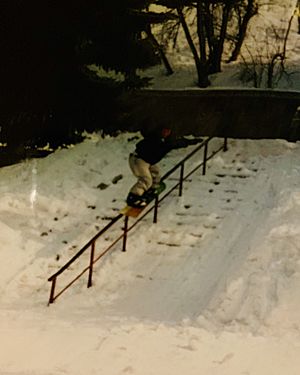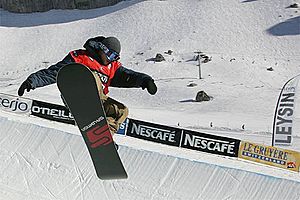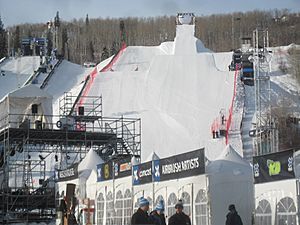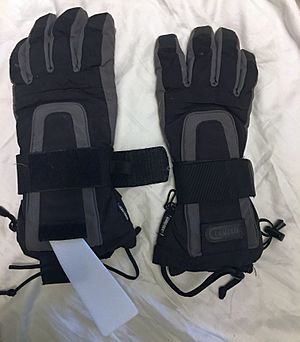Snowboarding facts for kids
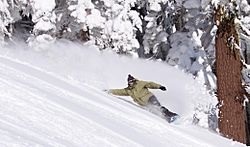
A snowboarder making a turn in fresh snow
|
|
| First played | 1979, Muskegon, Michigan, US |
|---|---|
| Characteristics | |
| Type | Outdoor |
| Equipment | Snowboard, bindings, boots |
| Presence | |
| Olympic | 1998 |
| Paralympic | part of the Alpine skiing programme in 2014 Officially added in 2018 |
Snowboarding is an exciting winter sport where you ride down a snow-covered hill on a board. It's a bit like surfing or skateboarding on snow! Your feet are usually attached to the snowboard with special bindings. Snowboarding is a popular activity for fun. It is also a competitive sport in the Winter Olympic Games and Winter Paralympic Games.
Contents
How Snowboarding Started
The story of snowboarding began in 1965. An engineer named Sherm Poppen from Muskegon, Michigan, wanted to make a fun toy for his daughters. He fastened two skis together and tied a rope to the front for steering. His wife called it the "snurfer" – a mix of "snow" and "surfer." The snurfer became very popular. A company sold about a million of them! In 1966 alone, over half a million snurfers were sold.
The snowboards we see today were developed by people like Tom Sims and Jake Burton Carpenter. They made big improvements. They also started important snowboarding companies.
- In 1968, Sherm Poppen held the first snurfing contest. Tom Sims, who loved skateboarding, was there. When Tom was in eighth grade, he made his own snowboard. He glued carpet to a piece of wood and put aluminum on the bottom. Later, in the mid-1970s, he started selling snowboards.
- Around the same time, in 1977, Jake Burton Carpenter from Vermont also made a big impact. He had loved snurfing since he was 14. At a snurfing contest, he showed off special bindings he designed. These bindings kept his feet securely on the board. That year, he started Burton Snowboards. His first snowboards were flexible wooden planks with water ski foot traps. At first, not many people bought them because they were expensive. Also, many ski hills didn't allow them. But Jake Burton Carpenter's company grew to be the biggest in snowboarding.
The first competitions with prize money were the National Snurfing Championships. In 1979, Jake Burton Carpenter entered with his own snowboard design. Some people didn't think he should use a non-snurfer board. But he was allowed to race in a special "Open" division, which he won. This event is seen as the start of competitive snowboarding.
As snowboarding got more popular in the 1970s and 1980s, other pioneers also designed new boards and gear. These early ideas helped create the snowboards we use today. Modern snowboards usually include a board, special bindings, and boots.
When snowboarding first started, many ski resorts didn't allow it. For a while, snowboarders and skiers didn't always get along. Early snowboards were often banned from ski slopes. Sometimes, snowboarders had to pass a skills test to ride the chairlifts. But as boards and riding skills got better, snowboarding became more accepted. By 1990, most major ski areas had special areas for snowboarders. Now, almost all ski areas in North America and Europe welcome snowboarders. Many even have special terrain parks with jumps and rails.
In 2012, the International Paralympic Committee announced that adaptive snowboarding would be part of the 2014 Paralympic Winter Games in Sochi. This is called "para-snowboarding."
Different Ways to Snowboard
Snowboarding has many different styles. Each style uses special gear and techniques. The most common styles are freeride, freestyle, and freecarve/race. People enjoy these styles for fun or in competitions.
Jibbing
Jibbing is like doing skateboard tricks on things that aren't just snow. These "jibs" can be metal rails, boxes, benches, or even logs. When you "jib," you jump, slide, or ride on these objects. This style came directly from skateboarding tricks like grinding. You'll often see jibbing in a resort's snowboard park. Some riders also do it in cities.
Freeriding
Freeriding is all about riding on natural, ungroomed snow. This is often away from the main trails. There are no set rules or courses. It’s about enjoying the mountain and being spontaneous. It can be like freestyle, but without using man-made jumps or rails. See also Backcountry snowboarding.
Freestyle
Freestyle snowboarding is all about doing tricks! Riders use natural features like bumps and cliffs. They also use man-made things like jumps, rails, and boxes. It's a very creative style of snowboarding.
Alpine Snowboarding
Alpine snowboarding is a style usually done on smooth, groomed slopes, called pistes. It's been an Olympic event since 1998. This style is sometimes called freecarving. It focuses on making smooth, linked turns. This is much like surfing or longboarding on pavement. There's usually not much jumping. Alpine snowboarders use special equipment:
- Boards are longer, narrower, and stiffer. This helps with carving sharp turns.
- Boots are made of hard plastic, like ski boots. But they are designed for snowboarding.
- Bindings are different too, often with a step-in design.
A good alpine snowboarder can make many turns in a row. They lean their body very close to the snow on each turn.
Slopestyle
In slopestyle, snowboarders ride down a course filled with obstacles. These can be jumps, rails, boxes, or other features. Riders do tricks on these obstacles. To win, a rider needs to perform difficult tricks smoothly and creatively.
Big Air
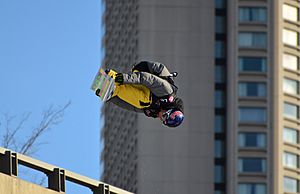
Big air contests are all about huge jumps! Riders launch off a large, specially built ramp. They do amazing tricks in the air. They try to go high and far, and land cleanly. Many contests also require very complex tricks.
Half-pipe
A half-pipe is a U-shaped ramp made of snow. The walls can be anywhere from 8 to 23 feet (about 2.5 to 7 meters) high. Riders go from one side of the pipe to the other. They do tricks in the air above the edges.
Snowboard Cross
Snowboard cross, also called "boardercross" or "SBX," is a race. Usually, four to six riders race down a course at the same time. The course has jumps, bumps (called berms), and other obstacles made of snow. It became an Olympic event in 2006.
Snowboard Racing
In snowboard racing, riders go down a course marked by colored flags or poles called gates. They have to go around the correct side of each gate. There are different types of snowboard races. These include races where riders go one at a time. Or side-by-side on parallel courses. Or several riders at once like in SBX.
Big Snowboarding Contests
There are snowboarding contests all over the world. These range from small local events to huge international competitions.
Some of the biggest snowboarding events include:
- The European Air & Style
- The Japanese X-Trail Jam
- Burton Global Open Series
- Shakedown
- FIS World Championships
- The annual FIS World Cup
- The Winter X Games
- Freeride World Tour
- The Winter Dew Tour
Snowboarding has been a Winter Olympic sport since the 1998 Winter Olympics in Japan. Olympic snowboarding events include big air, halfpipe, parallel giant slalom, slopestyle, and snowboard cross.
An event called Superpark, created by Snowboarder Magazine in 1996, invites top professional riders. They show off their skills on amazing, specially built terrain parks.
Snowboarding is also about having fun and friendship. Some events, called "Anti Contests," focus on this spirit. Examples include The Holy Oly Revival and The Nate Chute Hawaiian Classic.
The United States of America Snowboarding and Freeski Association (USASA) helps organize snowboarding competitions. It also provides guidelines for teaching in the U.S.
Staying Safe on the Slopes
Like other winter sports, snowboarding has some risks. But you can do a lot to stay safe and have fun.
Beginners are more likely to get hurt. This is especially true if they don't take lessons from a qualified instructor. About a quarter of all injuries happen to first-time riders. Experienced riders get hurt less often. However, their injuries can sometimes be more serious.
Common Injuries and How to Avoid Them
- Wrists: Wrist injuries are common in snowboarding. Wearing wrist guards can cut the risk of wrist injury in half! Many beginner lessons require them.
- Learning to Fall: It's important to learn how to fall correctly. Instead of putting your hands straight out to stop your fall (which can hurt your wrists), try to land with your arms spread out, like wings. Slap the snow with your whole arm.
- Head: Head injuries can happen. So wearing a helmet is highly recommended.
- Eyes: Goggles are important to protect your eyes from injury. They also protect from snow blindness. This can happen from the sun's strong UV rays reflecting off the snow. Wear UV-protection goggles even on cloudy days.
Unlike ski bindings, snowboard bindings don't usually release automatically when you fall. This can actually help protect your knees. This is because your feet are securely attached to the board. Knee injuries are less common in snowboarding than in skiing.
Sometimes, an ankle injury called "snowboarder's ankle" can happen. This is a fracture of the talus bone. It can be hard to see on a regular X-ray. So if your ankle hurts a lot after a fall, it's important to get it checked by a doctor.
Be careful in ski lift lines too! When you push yourself forward with one foot free, your other leg is still attached to the board at an angle. This can put stress on your knee if you fall.
Other Safety Tips
- Lessons: Taking lessons from a professional instructor is a great way to learn proper technique and safety.
- Helmets: Always wear a helmet designed for snow sports.
- Avalanches: If you're riding in backcountry areas (away from marked trails), be aware of avalanche danger. It's best to take an avalanche safety course and carry safety gear.
- Tree Wells: Be careful around the base of trees, especially after a heavy snowfall. Deep, loose snow called a tree well can form there. It can be dangerous if you fall in.
- Know Your Limits: Don't try slopes or tricks that are too difficult for your skill level. Ride with a buddy, especially in less crowded areas.
- Well-Fitted Boots: Make sure your snowboarding boots fit well. Your toes should be snug at the end of the boot when you're standing up. They should have a little room when you're in your snowboarding stance.
- Protective Gear: Some riders wear extra padding on their hips, knees, spine, and shoulders.
By following these safety tips, you can have an awesome and safe time snowboarding!
Snowboarding Lingo
Here are some common terms you might hear:
Stances
How a snowboarder stands on their board.
- Goofy Stance
- Riding with your right foot forward.
- Regular Stance
- Riding with your left foot forward.
- Switch Stance
- Riding in the opposite stance to what you normally use.
Parts of a Snowboard
- Binding
- The part that attaches your boots to the snowboard.
- Heel Edge
- The edge of the snowboard where your heels rest.
- Nose
- The front tip of the snowboard.
- Tail
- The back end of the snowboard.
- Toe Edge
- The edge of the snowboard where your toes rest.
Spins and Flips
These are types of tricks.
- Backside Rotation
- A spin where your back turns towards the direction you're going first.
- Frontside Rotation
- A spin where your front turns towards the direction you're going first.
- Back Flip
- Flipping backward over the heel edge of your board.
- Front Flip
- Flipping forward (face first) over the toe edge of your board.
- Cork (Corkscrew)
- A spin that's off-axis, meaning you're tilted while spinning, kind of like a corkscrew.
- Rodeo
- An off-axis flip where your head leads the rotation, often with a spin.
Snowboarding in Movies and Magazines
Films
Snowboarding movies are a big part of the sport. Every year, new films come out. They show professional riders doing amazing tricks and exploring incredible mountains. These movies help show off new styles and inspire other snowboarders. Some companies that make snowboards and gear also make these films. For example, the movie The Art of Flight (2011) featured famous snowboarder Travis Rice and his friends. They pushed the limits of the sport.
Famous Snowboarders
Here are some well-known snowboarders:
- Callan Chythlook-Sifsof (born 1989), American snowboarder
- Rosey Fletcher (born 1975), American snowboarder
- Ayumu Hirano (born 1998), Japanese snowboarder
- Chloe Kim (born 2000), American snowboarder
- Max Parrot (born 1994), Canadian snowboarder
- Zoi Sadowski-Synnott (born 2001), New Zealand snowboarder
- Shaun White (born 1986), American snowboarder and skateboarder
- Su Yiming (born 2004), Chinese snowboarder
- Scotty James (born 1994), Australian snowboarder
Cool Facts About Snowboarding
- Snowboarding was invented in the United States. It quickly became a favorite winter activity for people all over the world.
- By 1985, the first World Cup for snowboarding was held in Austria. This helped snowboarding become known as an official international sport.
- In 1990, the International Snowboard Federation (ISF) was created. It made rules for contests.
- Snowboarding officially became an Olympic sport at the 1998 Winter Olympics in Nagano, Japan.
- It was later added to the Winter Paralympic Games in 2014 in Sochi, Russia.
- Snowboarding magazines include Transworld Snowboarding, Snowboarder Magazine, and Whitelines (from the UK).
See also
 In Spanish: Snowboard para niños
In Spanish: Snowboard para niños
- American Association of Snowboard Instructors
- Glossary of skiing and snowboarding terms
- Lazboard
- Sandboarding
- Skiboarding



